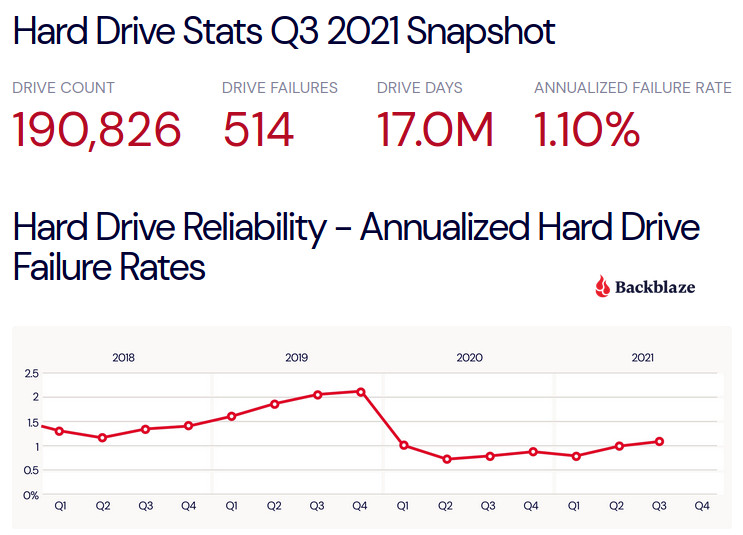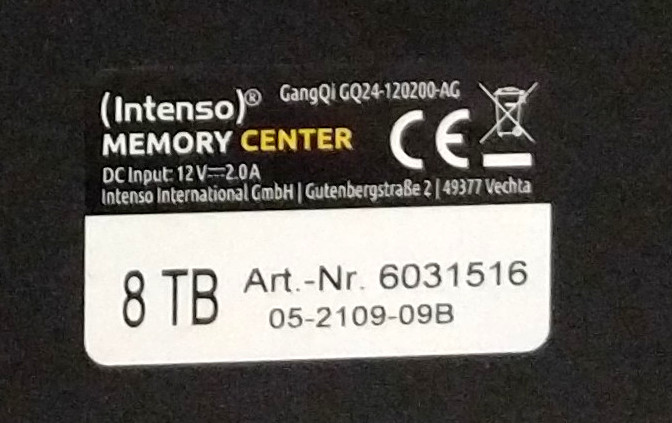possible (untested!) alternative:
the harddisk reliability toplist:
while this toplist says nothing about how reliable the harddisk can store and return exact copy of data written (!!!).
this has to be tested in additionally (long term stress test).
Backblaze regularly publishes statistics on their harddisk failure rates for different models.
also yearly data is published: (thanks! it is really really helpful 🙂
- 231 drives not included in the list above were either used for testing or did not have at least 60 drives of the same model
- drives which have less than 250,000 drive days, any conclusions about drive failure rates are not justified. There is not enough data over the year-long period to reach any conclusions. We present the models with less than 250,000 drive days for completeness only
- SEAGATE 6TB drive (model: ST6000DX000) leads the way with a 0.23% annualized failure rate (AFR).
- This model was also the oldest, in average age, of all the drives listed.
- followed closely by the perennial contenders from HGST:
- HGST 4TB drive (model: HMS5C4040ALE640) at 0.27%
- HGST 4TB drive (model: HMS5C4040BLE640), at 0.27%
- HGST 8TB drive (model: HUH728080ALE600) at 0.29%
- HGST 12TB drive (model: HUH721212ALE600) at 0.31%.
just imagine this worst case scenario:
- backup1 is done on external harddisk, daily
- every week backup1 is changed for backup2 (to keep one backup disconnected completely from ransomeware)
- in order to keep the database clean a restore of the database will have to be performed first
- now imagine, that because of a faulty external harddisk (a harddisk that does not return the same data that is written to it) faulty data will be restored from that harddisk… effectively corrupting the database
- if the error goes undetected, the database is corrupted over time up to the point of complete malfunction or breakdown
- now: how to find out when the corruption started? (to restore a sane copy) hard & massive amount of dataloss
- all because of a low in quality external harddisk
- so high quality backup is an absolute MUST (and if a high quality NAS with high quality harddisks costs extra, pay extra, but also: test, test, test…
- for gnu-linux:
- iterate over all harddisks and check smart status
- this should be a daily routine, but the admin-user can not rely on smart, it might detect an error only minutes before failure
- bad sector test
- surface test
- iterate over all harddisks and check smart status
- for windows:
- before usage & occasionally:


- WARNING! per default this does “only” a ntfs filesystem check!
- https://www.partitionwizard.com/partitionmagic/hard-drive-test.html
- https://www.chip.de/downloads/Aomei-Partition-Assistant-Standard-Edition_47044994.html
- before usage & occasionally:
- for gnu-linux:
- do not rely on brand x being reliable in the past
- consider using at least two external backup systems, if one turns out to be faulty
story goes like this:
- currently using 2x intenso 4TB with metall casing (work perfectly since ~3 years)
- the question was: can those be replaced with the 8tb intenso version?
short answer: no
just hope that this piece of mistake can at least be properly recycled.
it is time to write Seagate and Intenso angry mails and never buy from them again
this external harddisk (the USB-SATA-Adapter AND the harddisk itself) of the intenso 8tb are of catastrophic quality.
here are the reasons:
- completely useless as external backup harddisk: highly unreliable (just quits during longer write sessions) (this was tested on Windows Server 2012 R2 with Acronis)
- the USB-SATA Adapter is said to messes with the filesystem, so when the hdd is taken out of it’s case and directly SATA connected, can not be read
- if the Seagate itself was “okayish” and only the USB-SATA Connector was a catastrophe (so it could be at least opened and salvaged) but unfortunately both are crap? “great”
- according to many many amazon reviews, this harddisk is “no good” (can not store write and read data reliably… (BTRFS detects those errors, NTFS might not = corrupting the data) so the harddisk itself is utter “cheap” (170€ are not cheap!) crap)
- MTBF: 1Million hours, for comparison: the HUS726040AL has only 4TB but MTBF of 2Million hours! (it is one’s favorite harddisk 🙂 very reliable and speed is okay)
- HUS724040 (HGST Ultrastar 7K4000 4TB 64MB) probably also good
- so this is a “as catastrophic as it get’s” cooperation between intenso and Seagate, or maybe has the material to store data in those magnetic harddisk hit “a limit”? (or just has the cost-saving by using cheap parts “hit a limit” and produced massive amounts of useless waste (hope it can be recycled properly at least)
- is it shingled? (so no good for raid)
- yes it is
- “The data density of HDDs has quadrupled since 1990” (src)
- “Now, researchers say that graphene, which is a single layer of atoms arranged in a two-dimensional honeycomb lattice, lets them increase the density.” (src)
-
“The Cambridge scientists transferred graphene onto hard disks made of iron-platinum as the magnetic recording layer and tested Heat-Assisted Magnetic Recording (HAMR).”
-
“This new technology enables an increase in storage density by heating the recording layer to high temperatures.”
“Current COCs don’t perform at these high temperatures, but graphene does.”
-
“Graphene, combined with HAMR, can outperform current HDDs, providing an unprecedented data density higher than 10 terabytes per square inch, the researchers say.
- more storage scifi: “all of youtube in the fridge”
-
“DNA storage technology”
-
“already exists, but it never has been transformed into a valuable product for consumers.”
-
“That could change thanks to researchers at Los Alamos National Laboratory, who recently developed software, the Adaptive DNA Storage Codex (ADS Codex), which translates data files from the binary language of zeroes and ones that computers understand into the code biology understands.”
“DNA storage could disrupt the way we think about archival storage because the data retention is so long and the data density so high,” Bradley Settlemyer, a researcher at Los Alamos, said in a news release. “You could store all of YouTube in your refrigerator instead of in acres and acres of data centers.”
-
general info about the crap adapter and disk:
lsusb Bus 003 Device 006: ID 152d:578e JMicron Technology Corp. / JMicron USA Technology Corp. lsusb -vvv -s 006 Bus 003 Device 006: ID 152d:578e JMicron Technology Corp. / JMicron USA Technology Corp. Device Descriptor: bLength 18 bDescriptorType 1 bcdUSB 3.00 bDeviceClass 0 bDeviceSubClass 0 bDeviceProtocol 0 bMaxPacketSize0 9 idVendor 0x152d JMicron Technology Corp. / JMicron USA Technology Corp. idProduct 0x578e bcdDevice 20.07 iManufacturer 1 Intenso iProduct 2 External USB 3.0 iSerial 3 2021042440543 bNumConfigurations 1 Configuration Descriptor: bLength 9 bDescriptorType 2 wTotalLength 0x002c bNumInterfaces 1 bConfigurationValue 1 iConfiguration 0 bmAttributes 0xc0 Self Powered MaxPower 8mA Interface Descriptor: bLength 9 bDescriptorType 4 bInterfaceNumber 0 bAlternateSetting 0 bNumEndpoints 2 bInterfaceClass 8 Mass Storage bInterfaceSubClass 6 SCSI bInterfaceProtocol 80 Bulk-Only iInterface 0 Endpoint Descriptor: bLength 7 bDescriptorType 5 bEndpointAddress 0x81 EP 1 IN bmAttributes 2 Transfer Type Bulk Synch Type None Usage Type Data wMaxPacketSize 0x0400 1x 1024 bytes bInterval 0 bMaxBurst 15 Endpoint Descriptor: bLength 7 bDescriptorType 5 bEndpointAddress 0x02 EP 2 OUT bmAttributes 2 Transfer Type Bulk Synch Type None Usage Type Data wMaxPacketSize 0x0400 1x 1024 bytes bInterval 0 bMaxBurst 15 Binary Object Store Descriptor: bLength 5 bDescriptorType 15 wTotalLength 0x002a bNumDeviceCaps 3 USB 2.0 Extension Device Capability: bLength 7 bDescriptorType 16 bDevCapabilityType 2 bmAttributes 0x00000002 HIRD Link Power Management (LPM) Supported SuperSpeed USB Device Capability: bLength 10 bDescriptorType 16 bDevCapabilityType 3 bmAttributes 0x00 wSpeedsSupported 0x000e Device can operate at Full Speed (12Mbps) Device can operate at High Speed (480Mbps) Device can operate at SuperSpeed (5Gbps) bFunctionalitySupport 1 Lowest fully-functional device speed is Full Speed (12Mbps) bU1DevExitLat 10 micro seconds bU2DevExitLat 2047 micro seconds Container ID Device Capability: bLength 20 bDescriptorType 16 bDevCapabilityType 4 bReserved 0 ContainerID {d62a2515-01a8-f94c-9dd3-623391bc654c} can't get debug descriptor: Resource temporarily unavailable Device Status: 0x000d Self Powered U1 Enabled U2 Enabled # what is inside (the USB-SATA Adapter can tell this) hdparm -I /dev/sdc /dev/sdc: ATA device, with non-removable media Model Number: ST8000DM004-2CX188 Serial Number: XXXXX Firmware Revision: 0001 Transport: Serial, ATA8-AST, SATA 1.0a, SATA II Extensions, SATA Rev 2.5, SATA Rev 2.6, SATA Rev 3.0 Standards: Used: unknown (minor revision code 0x006d) Supported: 10 9 8 7 6 5 Likely used: 10 Configuration: Logical max current cylinders 16383 16383 heads 16 16 sectors/track 63 63 -- CHS current addressable sectors: 16514064 LBA user addressable sectors: 268435455 LBA48 user addressable sectors: 15628053168 Logical Sector size: 512 bytes Physical Sector size: 4096 bytes Logical Sector-0 offset: 0 bytes device size with M = 1024*1024: 7630885 MBytes device size with M = 1000*1000: 8001563 MBytes (8001 GB) cache/buffer size = unknown Form Factor: 3.5 inch Nominal Media Rotation Rate: 5425 # what the USB-SATA adapter does not support: access to the disk's SMART-health data smartctl -H /dev/sdc smartctl 6.6 2017-11-05 r4594 [x86_64-linux-4.19.0-18-amd64] (local build) Copyright (C) 2002-17, Bruce Allen, Christian Franke, www.smartmontools.org /dev/sdc: Unknown USB bridge [0x152d:0x578e (0x2007)] Please specify device type with the -d option. # is it shingled? if smartctl -l scterc,70,70 /dev/sdc > /dev/null ; then echo " is good"; else echo "no good sue vendor"; fi; no good sue vendor # yes it is! (no good for raid)
liked this article?
- only together we can create a truly free world
- plz support dwaves to keep it up & running!
- (yes the info on the internet is (mostly) free but beer is still not free (still have to work on that))
- really really hate advertisement
- contribute: whenever a solution was found, blog about it for others to find!
- talk about, recommend & link to this blog and articles
- thanks to all who contribute!






